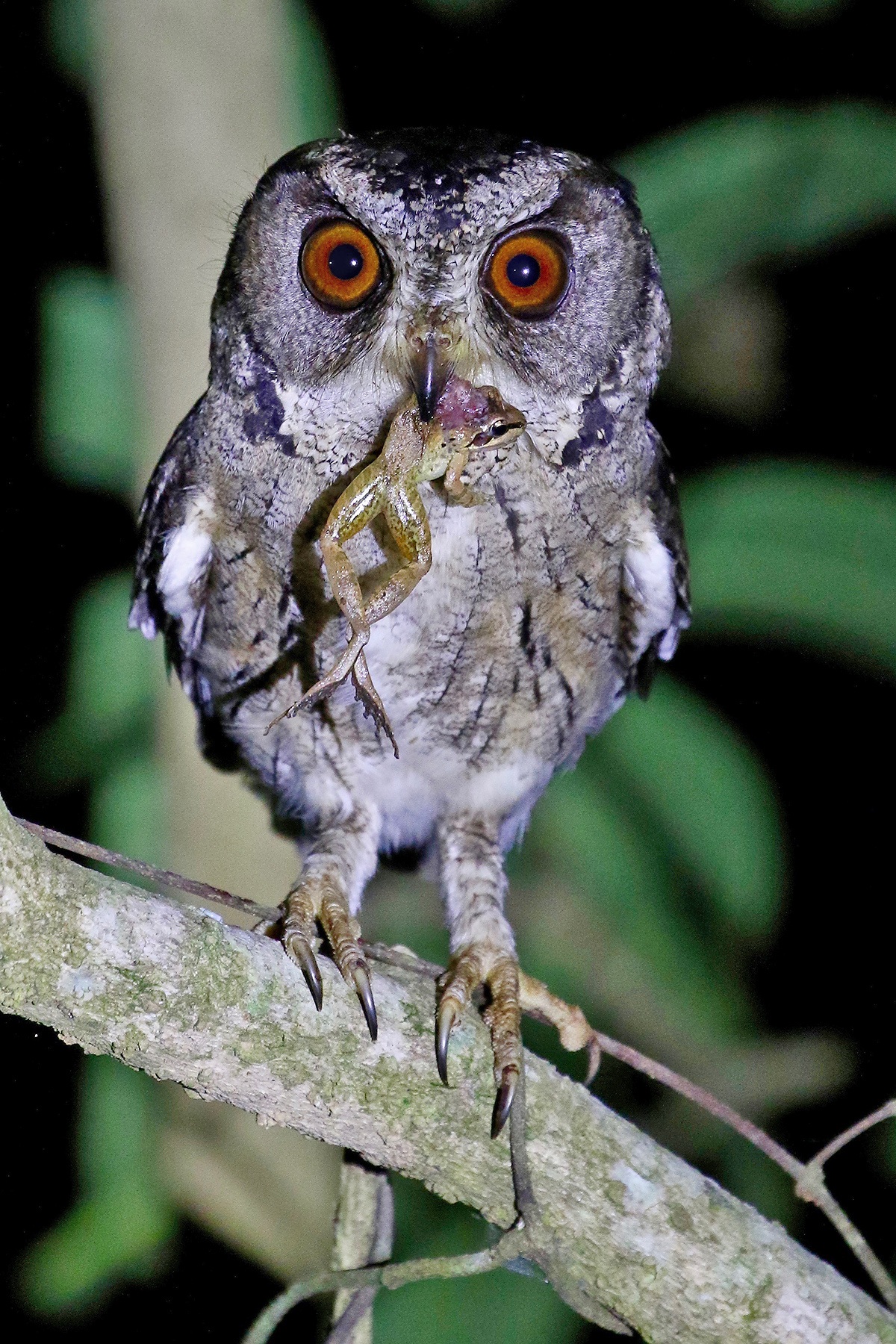SOUTH INDIA & ANDAMAN ISLANDS BIRDING TOUR: DETAILED ITINERARY
South India & Andaman Islands Tour: Day 1 Our South India & Andaman Islands birding tour begins this morning at Port Blair airport in India’s Andaman Islands. We will stay for five nights in these remote islands.
We will have time for some initial exploration on South Andaman Island this afternoon.
South India & Andaman Islands Tour: Days 2-5 The Andaman Islands consist of several hundred islands and a range of hills, rising to 800m, that form a spine along the main chain of the archipelago. Two monsoons a year ensure a high rainfall which, together with the tropical climate, creates ideal conditions for the development of rainforest. Indeed, much of the land surface of the Andamans is still covered in pristine forest and we will be concentrating on this rich habitat during our stay in these rarely visited islands. For part of the time we will also search for waders and other coastal species in the areas of mangroves and marshes, or along the idyllic, palm-fringed, sandy beaches.
The birdlife is, as one would expect from the position of the islands, a mixture of Indian and Southeast Asian forms, but the long period of isolation has also resulted in a high degree of endemism.
A number of the endemics are usually straightforward to find, and these include Andaman Serpent Eagle, Andaman Cuckoo-Dove, Andaman Green Pigeon, Andaman Coucal, Andaman Boobook, Hume’s Boobook, Andaman Woodpecker, Andaman Cuckooshrike, Andaman Bulbul, Andaman Shama, Andaman Flowerpecker, Andaman Drongo, White-headed Starling and Andaman Treepie.
With enough time on South Andaman at our disposal, we should also find most of the more difficult endemics, which include Andaman Teal, Andaman Crake, Andaman Wood Pigeon, Andaman Scops Owl, Andaman Masked Owl (or Andaman Barn Owl) and Andaman Nightjar.
Amongst the many other species that we will be looking for on South Andaman are Yellow and Cinnamon Bitterns, Striated Heron, Pacific Reef Heron, White-bellied Sea Eagle, Watercock, Pacific Golden Plover, Greater and Lesser Sand Plovers, Green Imperial Pigeon, Red Turtle Dove, Alexandrine, Red-breasted and Long-tailed Parakeets, Violet Cuckoo, Collared Scops Owl, Edible-nest and Plume-toed Swiftlets, Brown-backed Needletail, Collared and Blue-eared Kingfishers, Freckle-breasted Woodpecker, Black-naped Oriole, the distinctive andamanensis race of the Scarlet Minivet, Thick-billed, Clamorous Reed, Pallas’s Grasshopper, Dusky and Yellow-browed Warblers, and Olive-backed Sunbird. With luck, we will also come across Ruddy-breasted Crake, Slaty-breasted Rail or Mangrove Whistler.
South India & Andaman Islands Tour: Day 6 Today we will catch a morning flight to Chennai (formerly Madras) on the southeastern coast of mainland India and then an onward connection to Coimbatore.
From there we will travel to Ootacamund for an overnight stay.
Along the way we should see such widespread species as Little Cormorant, Indian Pond Heron, Great, Eastern Cattle, Intermediate and Little Egrets, Black and Brahminy Kites, Grey-headed Swamphen, Red-wattled Lapwing, Rose-ringed Parakeet, Asian Palm Swift, White-throated Kingfisher, Indian Roller, Barn and Red-rumped Swallows, Common Myna, House Crow, Indian Jungle Crow, Red-whiskered Bulbul and Pied Bushchat.
South India & Andaman Islands Tour: Day 7 Ootacamund, or ‘Ooty’ as it is widely known, is a sprawling hill station situated at about 2250m (7382ft) in the Nilgiri Hills. The town has a distinctly colonial atmosphere and it is still popular as a place to escape to from the high temperatures of South India’s lowlands immediately before the arrival of the monsoon rains.
As in many parts of the Western Ghats, most of the natural forest has been replaced with tea plantations and also by eucalyptus and conifer plantations. We shall search some ravines with remaining natural forest for Nilgiri or more widespread South Indian endemics and near-endemics such as Grey Junglefowl, Painted Bush Quail, Indian Scimitar Babbler, Black-chinned (or Nilgiri) Laughingthrush, the spectacular Black-and-orange Flycatcher, Nilgiri Flycatcher, White-spotted Fantail, the unobtrusive but often confiding Nilgiri Blue Robin (formerly included with the shortwings, as White-bellied Shortwing, and often surprisingly confiding) and Indian Blackbird, while with a bit of luck, we will also see the uncommon Nilgiri Wood Pigeon.
Other species we may well find include Bar-winged Flycatcher-shrike, Grey-headed Canary-flycatcher, Ashy Prinia, Tickell’s Leaf Warbler, Indian Blue Robin, Blue-capped Rock Thrush, Velvet-fronted Nuthatch, Olive-backed Pipit, Forest Wagtail, Indian White-eye and Common Rosefinch. With luck, we will find a wintering Kashmir Flycatcher.
Likely mammals include Nilgiri Langur, Gaur and Indian Giant Squirrel.
Later today we will descend to Mudumalai National Park, situated at the foot of the towering northern escarpment of the Nilgiri Hills, for a two nights stay.
South India & Andaman Islands Tour: Day 8 Mudumalai (together with the adjacent Bandipur sanctuary in Karnataka state) comprises a huge area of mainly dry deciduous forest and scrub. At this time of year the trees are bare and the ground is littered with huge dried leaves like a carpet of poppadoms, making it easy to see the birds but noisy underfoot. The sanctuaries and their buffer zones are situated in the lowlands at the foot of the Nilgiris and the seemingly endless landscape of leafless trees and dry grassland looks as if it must be devoid of birds, but in fact there is a rich variety.
Amongst the many species we may well see here are such South Indian endemics and near-endemics as Red Spurfowl, Blue-faced Malkoha, White-cheeked Barbet, Malabar Lark, Orange Minivet, Jerdon’s Leafbird, White-browed Bulbul, Malabar Whistling Thrush, Nilgiri Thrush, Yellow-billed Babbler, Indian Nuthatch (now treated as distinct from Chestnut-bellied) and Nilgiri Flowerpecker.
More widespread birds include Crested Serpent Eagle, Yellow-footed Green Pigeon, Spotted Dove, Plum-headed Parakeet, Asian Koel, Spotted Owlet, Savanna, Indian and Jungle Nightjars, Crested Treeswift, Blue-bearded Bee-eater, Eurasian Hoopoe, Coppersmith Barbet, Streak-throated Woodpecker, Black-rumped and Common Flamebacks, Brown, Bay-backed and Long-tailed Shrikes, Black, Ashy, White-bellied and Bronzed Drongos, Black-headed Cuckoo-Shrike, Brahminy Starling, Black-hooded Oriole, Rufous Treepie, Small Minivet, Common Iora, Gold-fronted Leafbird, Red-vented Bulbul, Brown-cheeked Fulvetta, Common Tailorbird, Blyth’s Reed and Greenish Warblers, Orange-headed Thrush, Oriental Magpie-Robin, Indian Robin, Tickell’s Blue Flycatcher, White-browed Fantail, Pale-billed Flowerpecker, Purple-rumped and Purple Sunbirds, and Chestnut-shouldered (or Yellow-throated) Sparrow.
If we are lucky we will also find the uncommon Spot-bellied Eagle-Owl and the restricted-range White-naped Woodpecker and White-bellied Minivet.
Likely mammals at Mudumulai include Southern Plains Grey Langur and if we are in luck we will come across Blackbuck or Dhole (Asian Wild Dog).
South India& Andaman Islands Tour: Day 9 After some final birding in the Mudumalai area we will climb back up to Ootacamund for an overnight nights stay, perhaps stopping for some birding en route.
South India & Andaman Islands Tour: Day 10 Today we head southwards as we descend from the Nilgiri Hills into the plains and then head up into the High Range for a two nights stay at Munnar. If we still have any outstanding specialities, we will have time for some extra birding at Ootacamund before we leave.
On the way, we will look out for troops of wizened-looking Bonnet Macaques and handsome Tufted Grey Langurs.
South India & Andaman Islands Tour: Day 11 Munnar is situated at 1450m (4757ft) and is the centre of a major tea-producing region. In consequence, most of the natural forest has been cleared, although remnants still survive.
We shall, however, be concentrating our efforts on the plateau of the High Range at Rajamalai (part of the Eravikulam National Park), above the highest tea plantations. This scenically spectacular area comprises a series of high, rounded, bare, rocky ‘whalebacks’ interspersed with grassland and dense patches of natural evergreen forest (known as ‘sholas’) in the sheltered valleys and hollows. Rhododendrons are a particular feature of the sholas although most will not be in flower at the time of our visit.
This is a rather specialized habitat but the limited variety of species includes several endemics; in particular Palani (or Grey-breasted) Laughingthrush, White-bellied Blue Robin, Nilgiri Pipit and Indian Black-lored Tit. The endemic Broad-tailed Grassbird also occurs here but is very difficult to see outside the monsoon season. We also have another chance here for Painted Bush Quail, Nilgiri Wood Pigeon and Black-and-orange Flycatcher.
Other species we may find in the area are Bonelli’s and Black Eagles, Alpine Swift, Hill Swallow, the near-endemic Square-tailed Bulbul, Blue Rock Thrush and Western Crowned Warbler.
The grassy plateau is also one of the last haunts of the rare Nilgiri Tahr, a curious kind of wild goat with small horns, and we have a good chance of finding some. The remaining patches of forest at lower altitudes hold the endemic Grey-fronted Green Pigeon, as well as Asian Fairy-bluebird and the near-endemic Southern (or Lesser) Hill Myna. We may also come across our first endemic Malabar Imperial Pigeon.
South India & Andaman Islands Tour: Day 12 This morning we will continue to Periyar National Park for a two nights stay.
Along the way, we will stop in an area of thicket to look for the uncommon endemic Yellow-throated Bulbul. This afternoon we will begin our exploration of Periyar.
South India & Andaman Islands Tour: Day 13 The extensive forests of Periyar National Park are justly famed for their wildlife, and in particular for the numbers of large mammals, including Asian (or Indian) Elephant, the magnificent Gaur (or Indian Bison), Wild Boar, Chital (or Spotted Deer) and Sambar. The handsome endemic Nilgiri Langur is also particularly common here.
During our stay, we shall concentrate on the mixed and evergreen forest and some of the endemic and near-endemic species we shall be hoping to see are Malabar Parakeet, Jerdon’s Nightjar, Indian Swiftlet, the beautiful Malabar Trogon, Malabar Grey Hornbill, Malabar (or Crimson-throated) Barbet, Malabar Flameback, Yellow-browed Bulbul, Malabar Woodshrike, the shy Wynaad Laughingthrush, Rufous and Dark-fronted Babblers, White-bellied Blue Flycatcher, White-bellied Treepie, Malabar (or Blyth’s) Starling, Loten’s Sunbird and Black-throated Munia.
If we are quiet on the forest trails we may hear the gentle rustle of dry leaves, usually the first sign of a feeding Red Spurfowl, Indian Pitta or Puff-throated Babbler. Oriental Scops Owls are remarkably common here and we may also encounter Indian Scops Owl and Brown Bookook.
Other species which we may well also find at Periyar include Black Baza, Crested (or Oriental) Honey-Buzzard, Changeable Hawk-Eagle, Indian Peafowl, White-breasted Waterhen, Common Emerald Dove, Vernal Hanging Parrot, Greater Coucal, Jungle Owlet (of the distinctive race malabaricum), Little Swift, the restricted-range White-rumped Spinetail, Chestnut-headed and Blue-tailed Bee-eaters, the huge Great Hornbill, Brown-capped Pygmy, White-bellied, Heart-spotted and possibly Rufous Woodpeckers, Lesser Yellownape, Paddyfield Pipit, Greater Racket-tailed Drongo, Indian Golden Oriole, Large Cuckooshrike, Black-naped Monarch, Indian Paradise Flycatcher, Grey-breasted Prinia and wintering Brown-breasted and Rusty-tailed Flycatchers, and Large-billed Leaf and Greenish Warblers.
South India & Andaman Islands Tour: Day 14 After a final morning at Periyar, we will transfer to Thattekad sanctuary, not far from Kochi (Cochin), for a two nights stay.
South India & Andaman Islands Tour: Day 15 Thattekad’s avifauna is very similar to that at Periyar, so we have a chance to catch up on anything we may have missed. This is the best area on the tour for the secretive endemic Grey-headed Bulbul and Crimson-backed (or Small) Sunbird.
The near-endemic Sri Lanka Frogmouth occurs in these forests and we may be able to locate one or two at a daytime roost (where their beautiful and intricately mottled plumage makes them amazingly hard to pick out).
We also have a realistic chance of encountering the rare and elusive Sri Lanka Bay Owl (which occurs in both South India and Sri Lanka) and chances to find Brown and Mottled Wood Owls and the impressive Spot-bellied Eagle-Owl. We will also have another chance for Sri Lanka Frogmouth.
South India & Andaman Islands Tour: Day 16 Our South India & Andaman Islands birding tour ends this morning or around midday at Kochi (Cochin) airport. There may be time for some final birding at Thattekad.

































